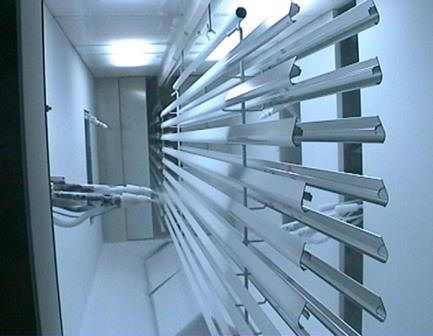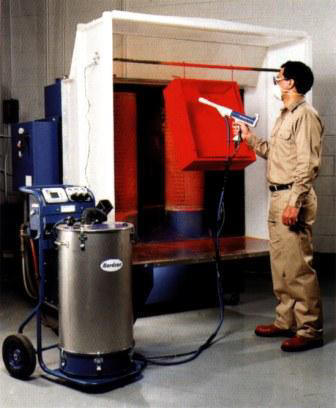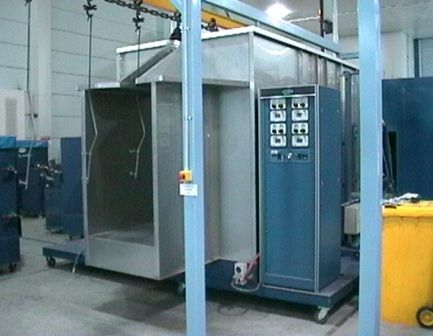A powder booth is an enclosure that is designed to contain the powder application process. A recovery system is attached to the powder booth shell. The recovery system uses a fan to pull air into the booth and prevent the over-sprayed powder from migrating out of the enclosure.
 The simplest powder booths are designed for a single operator to manually apply powder to a stationary product other booths are designed so that parts can be conveyed through the enclosure. Conveyorised systems may be designed for manual application from two sides, automatic application, or a combination of both, depending on the system requirements. The particular style, size and number of powder booths needed is related to the product size, the available space, the amount of capital and the volume of product to be coated.
The simplest powder booths are designed for a single operator to manually apply powder to a stationary product other booths are designed so that parts can be conveyed through the enclosure. Conveyorised systems may be designed for manual application from two sides, automatic application, or a combination of both, depending on the system requirements. The particular style, size and number of powder booths needed is related to the product size, the available space, the amount of capital and the volume of product to be coated.
Powder booth shells are occasionally made of painted steel but more often they are made of stainless steel, polypropylene, polycarbonate or other clear plastic, and a few are made of glass or polyethylene sheet. Painted steel is adequate but there is some risk that the paint will chip off and contaminate the over-sprayed powder in the reclaim system. Stainless steel makes a very durable booth shell with a smooth surface for ease of cleaning.
The part size will influence the height and width of the booth and the required product opening. The opening size must allow the part to enter with proper clearance around the edges. The amount of opening in the booth will determine powder contaminant air requirements. In order to contain the over-sprayed powder, the collector fan is designed to provide 100-120 lineal feet per minute (lfpm) of air velocity across all openings. Properly designed, the booth will have even airflow throughout the enclosure and not interfere with the coating process. Collector fan sizing must also consider safety. Each powder is rated with a lower explosion level (LEL).
The booth must be designed with enough ventilation to keep the powder concentration level below 50% of the LEL. The number of guns and nominal output per gun determines concentration.
Small batch booths are manufactured for lab work and low volume production situations.
 Walk-in manual booths are larger and can be used in production situations with or without a conveyor system. They are also typically used for non-reclaim situations. Walk-in booths are useful for large product that is not practical for hanging on a conveyorised system or for small volume operations. Walk-in booths can be used with or without a conveyor system and sized for virtually any product.
Walk-in manual booths are larger and can be used in production situations with or without a conveyor system. They are also typically used for non-reclaim situations. Walk-in booths are useful for large product that is not practical for hanging on a conveyorised system or for small volume operations. Walk-in booths can be used with or without a conveyor system and sized for virtually any product.
Conveyorised systems may be designed for manual operation only, automatic application or a combination of the two. They are designed for continuous application with parts traveling through on a conveyor system. Conveyorised booths provide an opportunity for higher volume production without the handling issues associated with batch operations. Automatic application can be 100% effective, but most booths that are designed for automatic application will also have manual stations for reinforcement.
Powder must be separated from the containment/safety air stream before it can be recovered for re-use or disposal. Additionally, this air must be filtered of all particulate larger than 0.03 microns before it can be returned to the workplace. The primary methods of accomplishing this powder separation are cartridge filtration, cyclone separation, and filter belt filtration. The most notable differences between these powder recovery systems is where the powder separation occurs and what method is used for the separation process.
Cartridge powder recovery systems typically use two kinds of filters; primary filters and final filters. The primary filters, usually cartridge filters, physically remove powder over-spray from booth air, either for recycling or disposal. Final filters capture any powder particulate larger than 0.03 microns, which is not removed by the primary filters ensuring that clean air is returned to the workplace.
The cyclone has been used as a means of separating solid particles from air streams in a variety of industries for a considerable period of time. The principle uses a vortex or cyclonic motion, generating a centrifugal force, which combines with gravity to separate the powder particles from the air stream and allowing them to fall to the bottom of the unit. It should be noted that the cyclone is a separator and not a filter. Therefore, additional filtration of the air is required downstream of the cyclone prior to returning the air to the plant.
The cyclone unit is connected to the powder booth by duct work that conveys the powder laden air from the collection point, within the powder booth, to the top of the cyclone unit. Therefore, the powder separation from the booth contaminant/safety air is performed at a remote location from the powder booth itself. The high velocity air flow used to convey the powder enters the top of the cyclone and is forced downward in a vortex motion. The centrifugal force pushes the heavier powder particles to the outside edge of the air stream and gravity causes them to fall to the bottom where they are collected in the reclaim canister. The recovered powder is then returned to the feed hopper either manually or via a transfer pump. As the air stream, now virtually free of powder particles, reaches the cone shaped neck of the cyclone unit, it is forced to return directly up the center of the cyclone.
The air then travels through more ductwork to a filtration unit, where any particles still suspended in the stream are filtered out and discarded. Once the powder is separated from the containment/safety air stream in the recovery system, it can be transferred to the guns and re-used. Deciding to re-use this over-spray powder is based upon economic reasons (cost of collection vs. cost of the powder) and quality issues (reclaimed powder vs. surface appearance). If a decision has been made to re-use this powder, then it should be mixed with virgin powder and sieved prior to being supplied to the powder spray guns.
 Colour change options are typically viewed in economic terms as a trade-off between time, cost, and floor space. Time is defined as both the number of man-made hours required and the amount of production downtime needed to accomplish the colour change. Cost is the total of the initial investment in the equipment, the cost of the production downtime and labour, along with the cost of the powder being used. Floor space is the area required for additional booths, collection modules, or powder recovery systems. Each of these items must be carefully analyzed before selecting a specific type of powder booth.
Colour change options are typically viewed in economic terms as a trade-off between time, cost, and floor space. Time is defined as both the number of man-made hours required and the amount of production downtime needed to accomplish the colour change. Cost is the total of the initial investment in the equipment, the cost of the production downtime and labour, along with the cost of the powder being used. Floor space is the area required for additional booths, collection modules, or powder recovery systems. Each of these items must be carefully analyzed before selecting a specific type of powder booth.
The complexity of the colour change operation is dependent on the type of booth and recovery system used for a specific application. To determine which type of booth and recovery system will be appropriate for a particular operation, a number of factors must be reviewed:
- Number of colours;
- Percentage mix of colours;
- Number of colour changes;
- Frequency of colour change;
- Cost of powder used.